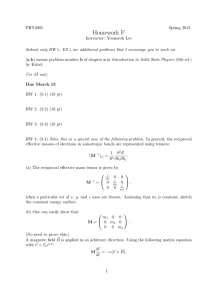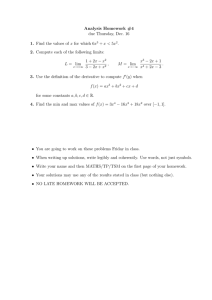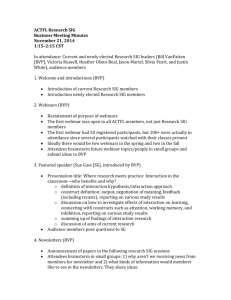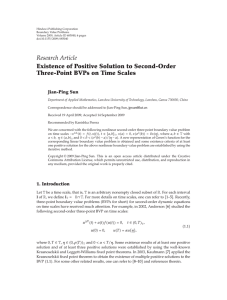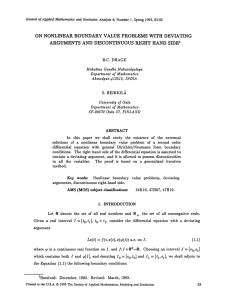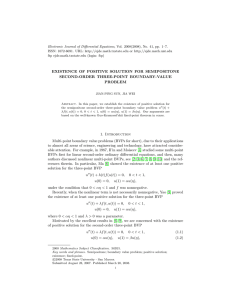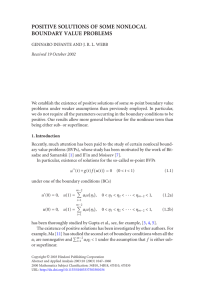Document 10677547
advertisement
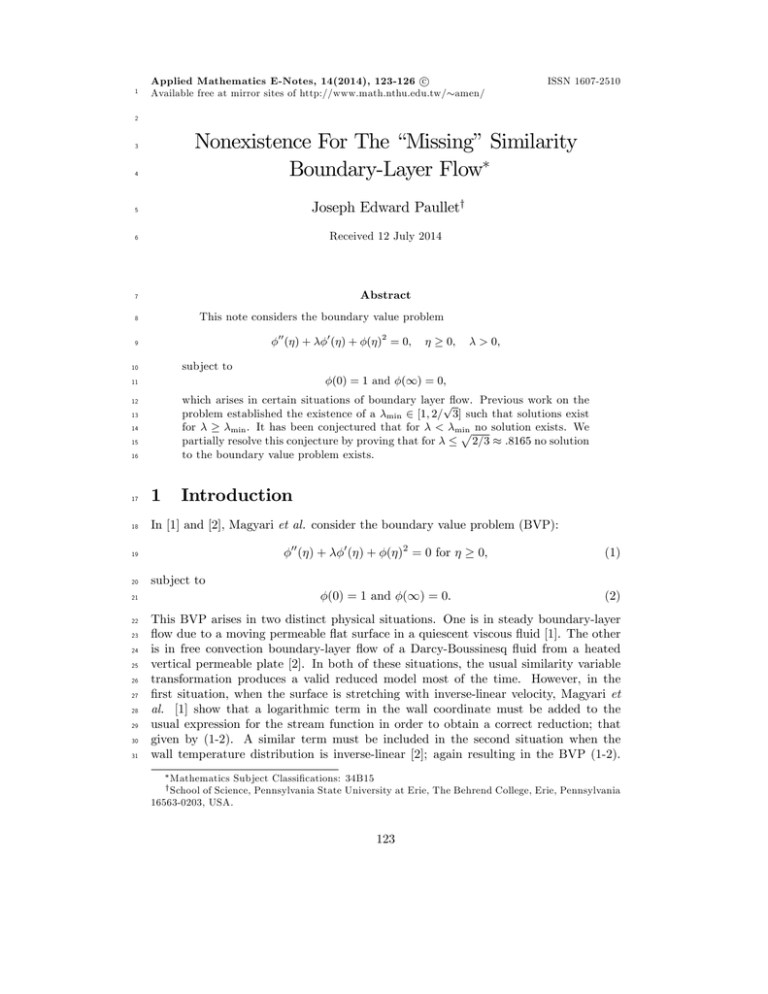
1 Applied Mathematics E-Notes, 14(2014), 123-126 c Available free at mirror sites of http://www.math.nthu.edu.tw/ amen/ ISSN 1607-2510 2 Nonexistence For The “Missing”Similarity Boundary-Layer Flow 3 4 Joseph Edward Paullety 5 6 Received 12 July 2014 7 Abstract This note considers the boundary value problem 8 00 9 ( )+ 0 ( ) + ( )2 = 0; 0; > 0; subject to 10 (0) = 1 and (1) = 0; 11 which arises in certain situations of boundary layerp‡ow. Previous work on the problem established the existence of a min 2 [1; 2= 3] such that solutions exist for < min min . It has been conjectured that for p no solution exists. We partially resolve this conjecture by proving that for 2=3 :8165 no solution to the boundary value problem exists. 12 13 14 15 16 17 1 Introduction 18 In [1] and [2], Magyari et al. consider the boundary value problem (BVP): 00 19 20 23 24 25 26 27 28 29 30 31 0 ( ) + ( )2 = 0 for 0; (1) subject to (0) = 1 and (1) = 0: 21 22 ( )+ (2) This BVP arises in two distinct physical situations. One is in steady boundary-layer ‡ow due to a moving permeable ‡at surface in a quiescent viscous ‡uid [1]. The other is in free convection boundary-layer ‡ow of a Darcy-Boussinesq ‡uid from a heated vertical permeable plate [2]. In both of these situations, the usual similarity variable transformation produces a valid reduced model most of the time. However, in the …rst situation, when the surface is stretching with inverse-linear velocity, Magyari et al. [1] show that a logarithmic term in the wall coordinate must be added to the usual expression for the stream function in order to obtain a correct reduction; that given by (1-2). A similar term must be included in the second situation when the wall temperature distribution is inverse-linear [2]; again resulting in the BVP (1-2). Mathematics Subject Classi…cations: 34B15 of Science, Pennsylvania State University at Erie, The Behrend College, Erie, Pennsylvania 16563-0203, USA. y School 123 124 32 33 34 35 36 37 38 39 40 Nonexistence for the "Missing" Boundary-Layer Flow Magyari et al. call these two special cases “missing” boundary-layer ‡ows because the usual similarity variable reduction misses valid and physically relevant results. For the BVP (1-2), Magyari et al. show that no solution exists for 0. Numerically, they …nd a value min 1:079131 such that a unique solution exists for = min and multiple solutionsp exist for all > min . Recently, Zhang [3] proved that there exists a min 2 [1; 2= 3] such that for min a solution to the BVP (1-2) exists. Existence or nonexistence of solutions for 0 < < min remains p an open question. We partially resolve this question by proving that for 0 < 2=3 0:8165 no solution to the BVP (1-2) exists. 41 2 42 The following Theorem is our main result. 43 44 45 Nonexistence Result 00 50 51 52 53 54 55 56 57 58 61 62 63 64 65 ( ) + ( )2 = 0 for 0; (3) subject to (0) = 1 and 0 (0) = ; (4) where is a free parameter. By standard existence and uniqueness theory, the IVP (3-4) will have a unique local solution for any value of . We will show that there is no value of such that the solution of the IVP (3-4) will exist for all 0 and satisfy the desired boundary condition at in…nity, (1) = 0. We begin by listing some properties that such a solution must satisfy. First note that the ODE (3) implies that ( ) cannot have a minimum. Thus, if 0 gives a solution to the BVP, then ( ) is monotonically decreasing for all > 0 and tends to zero as ! 1. If > 0 gives a solution, then ( ) must attain a positive maximum and then monotonically decrease to zero as goes to in…nity. A di¤erentiation of (3) yields 000 59 60 0 ( )+ 48 49 2=3 no solution to the boundary value problem (1-2) PROOF. Consider the initial value problem (IVP) given by 46 47 p THEOREM. For 0 < exists. ( )+ 00 ( ) + 2 ( ) 0 ( ) = 0: Note that after is ultimately decreasing, 0 cannot have a maximum. Thus for a solution, 0 is ultimately monotonically increasing and bounded above by zero. Thus 0 (1) 0 exists, and since (1) also exists, we must then have 0 (1) = 0. Next we derive several integral relationships that any solution must satisfy. An integration of the ODE (3) from 0 to gives 0 ( ) + ( ) + Z 0 (t)2 dt = 0: J. E Paullet 66 Letting 125 tend to in…nity and solving for the integral results in Z 67 1 (t)2 dt = + : (5) 0 68 0 69 70 0 Multiplying the ODE (3) by Again letting ( )2 2 and integrating from 0 to Z 2 + 0 0 Z 1 0 Finally, multiplying the ODE (3) by 0 to we obtain Z ( ) 0( ) 74 0 76 Letting ( )2 2 (t)2 dt + 77 79 Z 1 82 83 84 85 86 87 88 89 (t)3 dt = + + Z (t)3 dt = 0: 0 + 2 + Z 1 0 (t)2 dt: (7) 0 2 + 2+3 6 2 < + ; (8) p 2 2 or, after 2=3. Thus for p rearranging terms, 2 + 3 < 3 ; which cannot hold if 2=3 no solution to the BVP (1-2) exists for which 0. Next consider the possibility that > 0 gives a solution. As noted earlier, such a solution must attain a positive maximum, necessarily above one, and then decrease monotonically toward zero. Thus there exists a point 0 > 0 at which ( ) decreases through one. In the above expressions, we can integrate from 0 to > 0 and in (5), (6) and (7) replace the lower limit of integration with 0 and replace with 0 ( 0 ). Thus, for > 0 we again have 0 < ( ) < 1 and the exact same argument now implies that 90 91 1 Now, if 0 gives a solution to the BVP (1-2), then the solution is monotonically decreasing and 0 < ( ) < 1 for all > 0. Thus ( )3 < ( )2 for all > 0. Using this fact along with (5), (6) and (7) we obtain 80 81 (6) tend to in…nity results in 0 78 : and integrating, by parts where necessary, from 0 75 = 0: 2 2+3 6 (t)2 dt = 0 73 1 tend to in…nity and solving for the integral gives 71 72 ( )3 3 (t)2 dt + we obtain which is again contradicted if 2 + 3 0 ( 0 )2 < 3 2 ; p 2=3, proving the theorem. (9) 126 92 93 94 95 96 97 98 99 Nonexistence for the "Missing" Boundary-Layer Flow References [1] E. Magyari, I. Pop and B. Keller, The “missing”similarity boundary-layer ‡ow over a moving plane surface, Z. Angew. Math. Mech., 53(2002), 782–793. [2] E. Magyari, I. Pop and B. Keller, The "missing” self-similar free convection boundary-layer ‡ow over a vertical permeable surface in a porous medium,Transp. Porous Media, 46(2002), 91–102. [3] Z. Zhang, A two-point boundary value problem arising in boundary layer theory, J. Math. Anal. Appl., 417(2014), 361–375.

